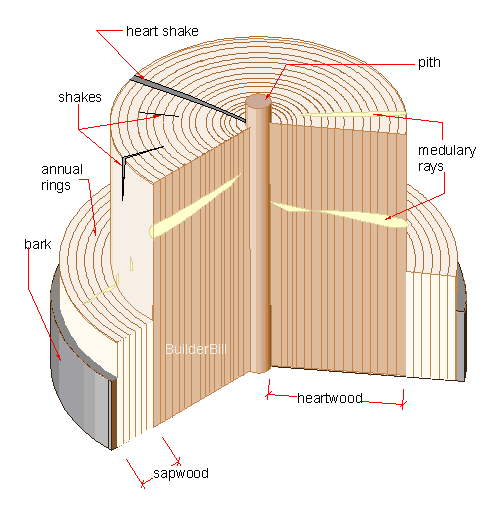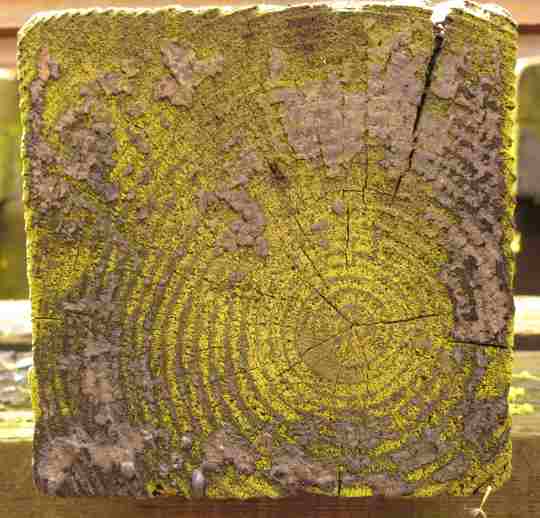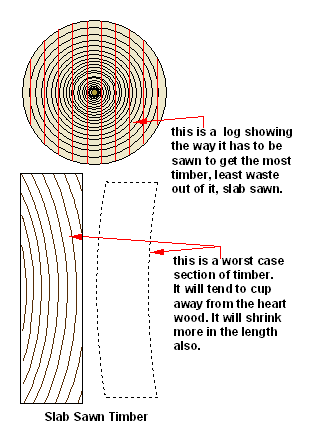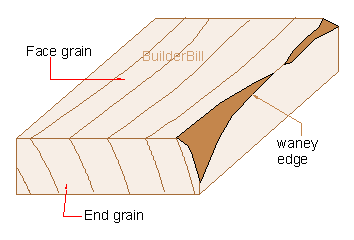 |
|||||||||||
Graphical Construction Glossary >> Woodwork. >> Timber Defects
Shakes can appear in the log before it goes to the mill. They are a function of the tree drying out and shrinking. The larger the more the chance of shakes. Once the timber is sawn into smaller sections then the risk of shakes being formed diminishes. Normal small shakes are a disfigurement and within reason they do not affect structural strength too much. Heart shakes can and do affect the strength badly. It is common for pieces of timber to split in half completely when working with affected ones. Wind shakes are fairly rare and the occur in trees that are still standing. If the tree is diseased or dead and it is losing it's natural strength then shakes occur in a horizontal direction, that is across the grain. Timber used in any structural application such as joists or rafter must not have wind shakes. Luckily they do not occur often.
It is or certainly was a common practise for logs to have their end grain sealed with pitch or any tar like substance to stop them drying out too quickly. This even extended to milled timber also. When the timber is to be installed in a place open to the weather (like in a deck) then it is essential to really seal the ends of the members as this is where the most movement occurs.
Cupping is caused again by poor seasoning but at the same time it can be said that it is also poor timber selection for the job in hand. This effect would not be acceptable in a door, but it may be controlled and minimised in a floor joist situation.
Waney edges are often seen in rustic type furniture and it really depends on the intended use. Remember that the timber next to the wane is the sapwood and as such it is not going to be as weather resistant as heartwood. Twisting is always a problem. Timber may look good just out of the stack and in a few days it may take on a twist. To try to minimise it always keep the timber stacked true and flat and well supported until it gets fixed into it's final position. I once asked the manager of our local timber yard "when the boat building guy was coming in to pick up all his pre-curved and twisted timber" pointing to a pile of useless lengths that had been ruined by leaving it lying all over the place. Needless to say he was not amused :-) Knots can affect the strength of timber enormously and softwood timber that is more prone to knots when being used for stuctural work is often stress graded. If you didn't find exactly what you are looking for try this search tool that will search the site and the web. "What can be added to the happiness of a man who is in health, out of debt, and has a clear conscience? "When we build, let us think that we build for ever."John Ruskin 1819-1900 |
Hire Equipment  Furniture Fittings - Architectural Hardware - Electronic Locking Systems - Technical Hardware BuilderBill sponsorship Glossary Pages.Roof Glossary and Roofing Formwork Glossary and other tempory work. Hand Tools Glossary Power Tools Glossary Asbestos Glossary Woodwork Glossary Stair Glossary Concrete Glossary Masonry Glossary doors Glossary BuilderBill Books Building Maths  Stair Design  Asbestos Book |
||||||||||
|
|
|||||||||||
|
Please Note! The information on this site is offered as a guide only! When we are talking about areas where building regulations or safety regulations could exist,the information here could be wrong for your area. It could be out of date! Regulations breed faster than rabbits! You must check your own local conditions. Copyright © Bill Bradley 2007-2012. All rights reserved. |
|||||||||||



